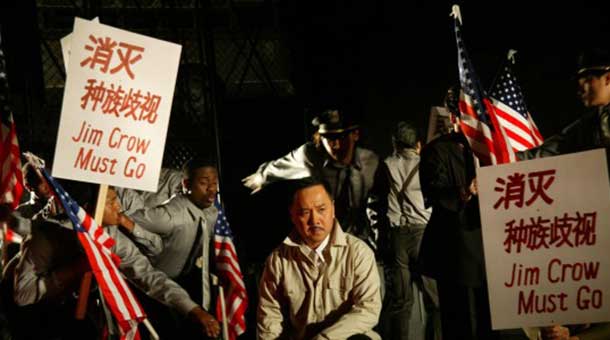Bringing King – China
Bringing King To China
Thursday: 2:30 pm – Rotary Center
Friday: 6:30 pm – Rock County Historical Society
 Category: Documentary
Category: Documentary
Country: China,India,Iraq,U S A
Language: English
Rating: PG-13
Runtime: 85 min.
Director: Kevin McKiernan
Producer:
Website: Bringing King To China
Facebook: Bringing King To China
‘Bringing King to China’ is the story of a young Fulbright scholar and her efforts to bring the non-violent ideas of Martin Luther King, Jr. to China. The main character is Caitrin, a Mandarin-speaking woman who studied both Asian and African-American history at Stanford University. Her improbable dream is to build a human rights bridge between nuclear superpowers China and the U.S., an idea she developed after graduation from college when she worked at the King Institute at Stanford. Her goal is to use Chinese theater to show the world a “positive face of America.” Caitrin’s dream, which blossomed in the post-9/11 world of the Iraq and Afghanistan wars, has been been featured on NPR, in The New York Times and in The Los Angeles Times.
aitrin’s journey begins after worldwide protests fail to stop the Iraq invasion and she learns (mistakenly) that her father, who is an ABC journalist covering the war, has been killed by a suicide bomber. In this bittersweet, coming of age story Caitrin reaches out to her father, as she gradually discovers a deeper, more complex Martin Luther King, Jr. than the “I Have a Dream” figure celebrated each January in parades and school recitations. The MLK she is trying to bring to China is a visionary who went beyond civil rights to become an active force for peace on the international stage.
The film opens in 1996 in Beijing where Caitrin—then a 16 year old exchange student– is confronted by the police in Tiananmen Square. The next scene is 12 years later, on a train in the Chinese countryside. Now a teacher in China, Caitrin reflects on the events that shaped her journey of self-discovery into the life of Martin Luther King (‘I’m a 26-year old white girl in China, trying to do a story about a black man who died 12 years before I was born’).
Before casting the Beijing play, Caitrin decides to bring members of the National Theater of China to the United States to research the U.S. Civil Rights Movement. The Chinese visitors meet African-American leaders in Oakland and Palo Alto, California, travel to Birmingham, Alabama to see the park where police dogs attacked protesters in 1963, visit the Ebenezer Baptist Church in Atlanta, Georgia, where Dr. King once preached and meet with Dr. King’s older sister. The trip to America culminates in Memphis, Tennessee at the Civil Rights Museum and Lorraine Motel where King was assassinated. Several colleagues of the late civil rights leader are interviewed on camera, including a friend who stood next to King when he was shot. Despite the valuable history lesson the visitors receive (before their trip to the U.S., none of the visitors had met an African American), the protagonist despairs that the visitors have not taken the costly trip seriously and that Martin Luther King will be caricatured on stage as a ‘Walt Disney’ figure.
Characters in the film include: Ken, the lead Gospel singer, who believes he has a spiritual mission in China and Wu, the talented Beijing director who wants to alter the script and believes that Americans tend ‘to interfere’ in other people’s business. Caitrin spars with Wu over the accuracy of his portrayal of King. For his part, the director complains that she has no theater background and criticizes what he believes are her efforts to convert his accomplished theater troupe to non-violence (‘they are actors, not philosophers’). Other characters include Liu, the Beijing producer who is offended by the protagonist’s demands for the receipts requested by Caitrin’s American funders, and Yan Shi Kui, Caitrin’s Buddhist mentor, a one-time heartthrob on the soap opera circuit who persuades her of the lasting impact of bringing MLK to China. Also featured are Alison, the choreographer, and Miao, her beloved assistant, whom she wrongly believes has betrayed her in negotiations with the National Theater of China. The cultural clash inherent in the co-production challenges everyone, even the supporting characters.
On their way back to China, the visitors stop in Santa Barbara. They are treated to a musical tribute by a gospel choir, an official reception by the Chinese-born Chancellor at UC Santa Barbara and meetings with Chinese and African-Americans. Later, they are guests of honor at a local high school, where 1,300 pupils give them a standing ovation as Dr. King’s ‘I Have a Dream’ speech is preformed simultaneously in English by a black college student and in Mandarin Chinese by Yunbai, the delegation’s 16-year old student from Beijing. The U.S. segment is punctuated by moments of humor, including exchanges in Chinese at Graceland, the former home of Elvis Presley, and a scene at a Beale Street club in Memphis where a Beijing actor is invited on stage to sing ‘Heartbreak Hotel’ with a honky-tonk band.
‘Bringing King to China’ is a daughter-father story that plays out against her struggle to build a bridge between the U.S. and China. As it turns out, Caitrin’s bridge is full of unexpected “potholes.” In the journey to find independence, Caitrin comes to realize that genuine cross-cultural dialogue entails a gritty struggle to find common ground.
The film provides a rare lens for viewing the history of the Civil Rights Movement from an Asian perspective. The Chinese analysis of civil disobedience challenges western viewers to wrestle with King’s more profound teachings, while Caitrin’s tender journey forces her to confront both her own limitations and the contradictions inherent in trying to bring wisdom to another culture.

